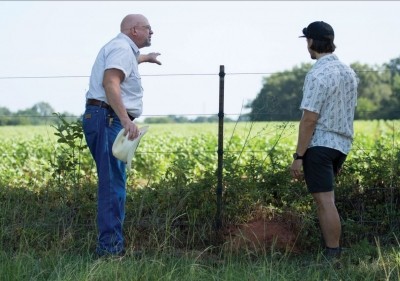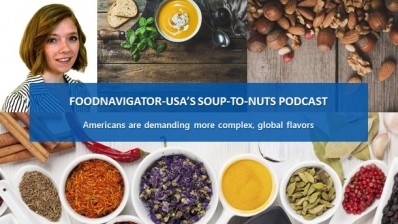Soup-To-Nuts Podcast: Grass fed beef is on the upswing, but must overcome significant challenges
According to a recent report produced through a collaboration of the Stone Barns Center for Food and Agriculture and investors with Armonia, Bonterra Partners and SLM, the US grass fed beef market is estimated to be worth $4 billion at retail and food service – a mere 4% of the total US beef market. Of this, only about $1 billion comes from products actually labeled as grass fed – the remaining is consumed unknowingly as part of a mix with fattier conventional beef trim in ground beef.
Even though that doesn’t sound like much, grass fed beef has significant potential as illustrated by its rapid growth at retail, which Nielsen data shows has double year over year from $17 million in 2012 to $272 million in 2016.
Industry players, including grass fed beef manufacturer and supplier Verde, predict this trend will continue and could capture as much as 5-6% of market share in the next five years. But, they acknowledge that in order for grass fed beef to reach its full potential, it needs to overcome significant challenges, including market confusion about the definition of grass fed beef, uneven quality production, consumer awareness and premium pricing that can reach upwards of 70% more than conventional alternatives.
In this episode of FoodNavigator-USA’s Soup-To-Nuts podcast, Verde’s Vice President of Marketing Pete Lewis explains how grass fed beef has emerged from a niche claim to one that now appears on mainstream products, such as Slim Jim. He also acknowledges that while 80% of consumers have heard the claim – far fewer have tried it. With this in mind, he walks through what is holding back shoppers – and the category – and what it will take to get more people to put grass fed beef in their carts.
Flavor, experience, health and animal welfare drive consumer interest
Lewis explains that US consumer interest in grass fed beef in many ways mirrors that of the founder of Verde, who discovered grass fed beef in 2005 and was wowed by its flavor and the ethos that surrounded the idea of free-range cows foraging their food and living the way nature intended.
CEO and Founder Dana Ehrlich discovered grass fed beef while on a ride with cowboys in South America and “it just really struck a chord as very memorable … then he came back home and he went to a steak house and had really the opposite experience – he had a bad steak,” Lewis explained.
Ehrlich investigated the difference and discovered that at the time there was no major importer of grass fed beef – so he decided to change that. He built a supply line that now services many major grocery retailers and supplies his company’s branded products, Lewis said.
Grass fed beef will follow the path of organic dairy
With a ready supply chain, Lewis also predicts that the growing popularity of grass fed will follow the same arch as organic dairy.
“Grass fed beef is growing rapidly and has been for years – sustained double digit growth for over five years, and while it is a smaller base, it is really finding an opportunity similar to organic dairy,” which is now about 10% the volume or dollar share on the fluid side, Lewis said. He added that many major retailers already sell that much or more, and it is only a short matter of time before the entire market share is lifted – especially given 80% of consumers have now heard of grass fed, even if most have not tried it.
Price is a top barrier to expanding grass fed beef sales
One of the major reasons for the discrepancy between consumer awareness of grass fed beef and trial is price, according to Lewis. Indeed, Nielsen data shows in 2016 grass fed beef cost 71% more than conventional beef at the retail level. This is higher than even organic, which as 63% more expensive than conventional at that time.
According to the Stone Barns Center for Food and Agriculture the high price of grass fed beef can be attributed in part to inefficient supply chain as well as a longer production cycle than conventional beef.
It explains that manufacturers of grain-fed beef have streamlined operations so that they can process cattle for as little as $100-120 per head, whereas most grass fed animals come from programs that are too small to access the hyper-efficient processing plants and therefore must use smaller regional plants that can charge upwards of $400-800 per head. In addition, the report notes that distributors for grass fed beef often charge 12-25% compared to 7-10% for conventional.
Lewis suggested that another reason for the higher prices and the lower trial rates is lack of availability and that if there was increased access, both the price and adoption would improve.
Who is buying grass fed beef – and who isn’t?
In making the case for why more retailers should stock grass fed beef, Lewis noted the typical grass fed buyer is one who many retailers are competing for because they are willing to pay a premium for higher quality products that align with their values.
“The millennial mom, she is really making a lot of decisions about what she wants to feed her family … and they are willing to invest in better food as a priority,” he said. He also noted that grass fed beef indexes well with urban couples, in rural areas and “a small portion of the older generation,” which might eat grass fed beef because it reminds them how beef used to taste.
As a firm believer in the benefits of grass fed beef, Lewis said that Verde is working hard to expand beyond these core shoppers and attract additional consumers by tweaking packaging, offering value added grass fed beef products and teaching people how to prepare the beef.
Manufacturers and suppliers must overcome label confusion
As Verde and other players in the grass fed beef space strive to expand the appeal of their product, they also need to address the widespread confusion about what grass fed actually means, and why it commands a higher price.
Like other controversial marketing terms, such as natural, grass-fed has no formal regulatory definition – although the US Department of Agriculture did define the term at one point, but revoked the label standard in 2016. Despite that, it will still verify if a company meets its own grass fed claim standards. Although, to hear Lewis explain it, this isn’t necessarily all that helpful.
He suggested what is more important is for companies to explain directly to consumers what their products represent and what their standards are.
“We just want to stand for what we stand for, which is 100% grass fed and finished, 100% pasture raised … and we think that is both what makes the best grass fed beef and what consumers want,” he said, adding, “we have quality standards that we really set in terms of the breed, the farming practices” and ensuring that cows eating a diversity of plants, herbs and weeds for a better flavor.
Progress underway to improve grass fed production and access
The US grass fed been market also is working hard to ensure that other players meet consumer perceptions and demand. For example, according to the Stone Barns Center for Food and Agriculture report, the grass fed industry is looking for ways to produce high-quality, well-finished grass fed beef by creating an aggregated seasonal finishing production process across different regions that account for the weather.
It also notes that US ranchers are looking for ways to unlock access to conventional beef supply-chain infrastructure to lower processing costs by better coordinating across the value chain through cooperative production and marketing arrangements
Finally, the grass fed beef industry is looking to create well-managed, scaled-up finishing systems that would bring production costs closer to those of conventional feedlot operations, without, of course, sacrificing the values that grass fed projects.

















